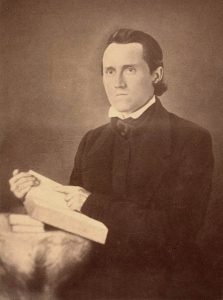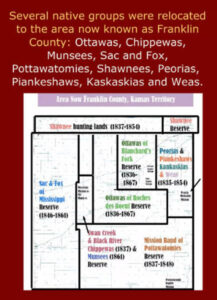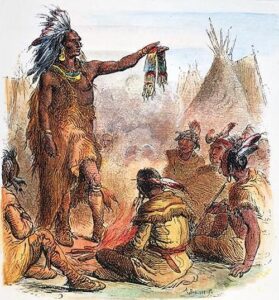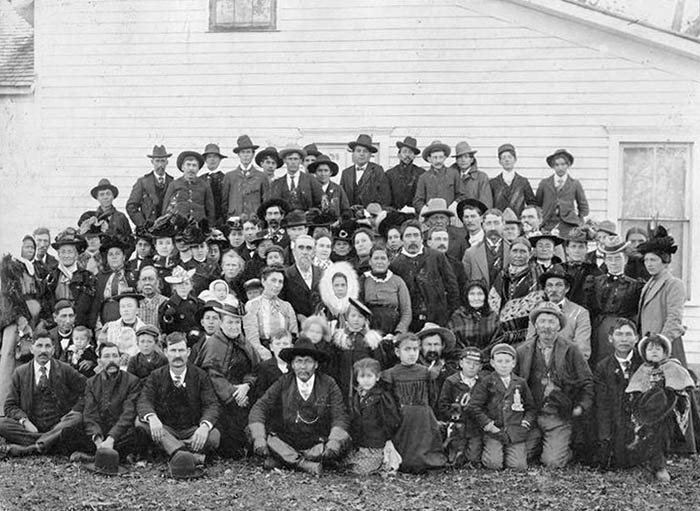Franklin County, Kansas, was included in the tract of land ceded to the Great and Little Osage Indians on November 10, 1808, and receded by them to the government in 1825.
On August 30, 1831, a treaty was concluded between the Ottawa Tribe and the United States Government that was ratified on April 6, 1832. By its terms, the Ottawa, numbering about 200 and residing on Blanchard’s Fork of the Great Auglaize River and at Oquanoxa’s village on the Little Auglaize River in Ohio, ceded to the United States two tracts of land containing 21,760 acres and received in exchange for the same a tract of land in Franklin County, containing 34,000 acres, to be located adjoining the south or west line of the reservation granted to the Shawnee of Missouri and Ohio.
By the same treaty, a second band of Ottawa Indians, residing at and near the places called Roche de Boeuf and Wolf Rapids on the Miami River of Lake Erie, within the State of Ohio, ceded to the United States two tracts of land, containing in the aggregate 28,157 acres, and received in exchange therefor 40,000 acres adjoining the lands assigned to the Blanchard’s Fork and Oquanoxa’s village Indians mentioned above.
These two bands of Ottawa received, in the aggregate, 68,157 acres of land in Franklin County. The tract was located very nearly in the center of the county. The Blanchard’s Fork band came to their reservation in 1836 and was soon followed by the Roche de Boeuf band.
The chief of the first band was Notno, and the chief of the second was Compghau. Shortly after arriving at their new homes, the two bands united under one chief, Compghau, who was continually elected to that position until his death. Besides this chief, they had a second or subordinate chief, a council, a constable, an assessor, and a collector, the taxes collected being used to defray government expenses.
Their subsistence for the first year after their arrival was provided by the Government. During this year, the Indians built bark huts in the woods in which they lived until taught by Reverend Jotham Meeker, who met them at Kansas City and led them to their reservation to cut logs and make log huts, in which art they soon acquired considerable skill. To aid them in constructing these houses, the Government loaned to the first band $2,000, which was to be paid when the lands in Ohio ceded to the Government were sold, and to protect them from the weather while their houses were built. The Government also gave them “Russian Sheeting sufficient for tents for their whole band” and other necessities.
The Roche de Boeuf band were similarly aided to make their settlement and homes.
The change in climate proved quite unfavorable to their health. Chills and fever, common in uncultivated countries, carried off in a few years half of their original number, notwithstanding the watchfulness and diligence of Reverend Jotham and Mrs. Meeker. These and other troubles incident to a new country being overcome, they made considerable progress in agriculture and gained considerable educational and religious knowledge.
The great flood of 1844 destroyed much of their property and was a great disaster and hindrance to their progress. After the water subsided, they removed their houses, which had been built in the valley of the Marais des Cygnes River mostly, to the high ground, log by log, afterward making even more rapid progress than before the flood.

Jotham Meeker
The Ottawa had several laws, including ones that prohibited theft, slander, the retention of a borrowed article beyond a specified time, selling or giving away of intoxicating liquors, fining drunkards $5 for the first offense, $10 for the second, and for the third offense the guilty party was to be turned over for punishment under the laws of the United States.
During the first year, there were no religious conversions. In the second year, David Green experienced religion and became of great assistance to Reverend Meeker in his labors among the tribe. After becoming somewhat enlightened, they observed the Sabbath with great strictness.
In 1854, about 300 Chippewa Indians were removed to a small reservation immediately west of the Ottawa Reserve. Their reserve was about seven miles long by two and a half miles wide. In 1860, about 50 Munsee joined the Chippewa. The Moravian missionaries, among them Reverend G. F. Oehler, came out with the Munsee. The reservation was reduced in size from time to time until it contained seven sections, or 4,480 acres, one-half in Greenwood and one-half in Lincoln Township. They were under the Sac and Fox Agency until that tribe was moved from the county and attached to the Potawatomi Agency.
On June 24, 1862, a treaty was made with the Ottawa, by which they were to become citizens of the United States in 1867. By the same treaty, each head of a family received 160 acres. For other members of the tribe, 80 acres of land was fee simple, and to provide for the education of their posterity, 20,000 acres of land were set apart to endow a school. In addition, one section of land for a school site said school to be for the exclusive and perpetual use of the Ottawa Indians and their posterity.
The Piankeshaw, Wea, and Peoria, by the treaty of October 29, 1832, had set apart a reservation which, in Franklin County, included a tract in the east part, about 12 by 15 miles in extent, embracing Peoria Township, about one-half of Franklin Township, and about two miles of the north end of Cutler Township.
By the treaty of February 23, 1867, this tribe of Indians agreed to dispose of their allotments in Kansas and to remove to a new reservation in the Indian Territory (Oklahoma) within two years. By this treaty, the adult Indians were allowed to sell their own lands, and the chiefs were allowed to sell the lands of minors and incompetents.
On February 18, 1867, a treaty was made between the Sac and Fox and the United States, by which that confederated band ceded to the United States their remaining lands in Franklin County and received in exchange a tract of land in the Indian Territory south of the Cherokee lands, not exceeding 750,000 acres in extent. In July, this treaty was ratified, and immediately after that, the lands were thrown open to entry and settlement.
Compiled & edited by Kathy Alexander/Legends of Kansas, October 2023.
Also See:
Native American History of Kansas
Sources:
Cutler, William G; History of Kansas; A. T. Andreas, Chicago, IL, 1883.
Emigrant Indians in Franklin County




